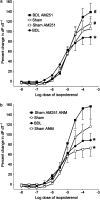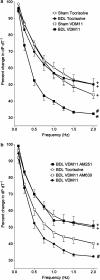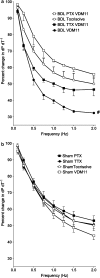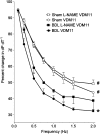Role of endocannabinoids in the pathogenesis of cirrhotic cardiomyopathy in bile duct-ligated rats
- PMID: 16025138
- PMCID: PMC1576281
- DOI: 10.1038/sj.bjp.0706331
Role of endocannabinoids in the pathogenesis of cirrhotic cardiomyopathy in bile duct-ligated rats
Abstract
Cardiac contractility in cirrhosis is normal at baseline but hyporesponsive to stimuli, a phenomenon known as 'cirrhotic cardiomyopathy'. The pathogenesis remains unclear. Endocannabinoids are vasoactive, but have not previously been examined in the cirrhotic heart. We therefore aimed to systematically clarify a possible role of endocannabinoids in the pathogenesis of cirrhotic cardiomyopathy. Cirrhosis was induced in Sprague-Dawley rats by bile duct ligation; controls underwent a sham operation. At 4 weeks after operation, isolated left ventricular papillary muscle contractility was studied. Dose-response curve for a beta-adrenergic agonist isoproterenol was constructed in the presence and absence of a CB-1 antagonist AM251 (1 microM). Cirrhotic muscles had a blunted response to isoproterenol, which was completely restored by AM251. Dose-response curves to anandamide, and CB-1 and CB-2 protein and mRNA expression in Western blot and reverse transcriptase-polymerase chain reaction experiments were not significantly different between cirrhotic and sham muscles. Force-frequency relationship studies were performed in cirrhotic and normal muscles. At higher frequencies, anandamide reuptake blockers (VDM11 and AM404) significantly enhanced muscle relaxation in cirrhotic muscles, but not in controls. This effect was completely blocked by AM251 and pertussis toxin, whereas tetrodotoxin partially reversed it. Taken together, these results indicate a pathogenic role for increased local (neuronal) production of endocannabinoids, mediated by a G(i)-protein-dependent CB-1-responsive pathway in cirrhotic cardiomyopathy. The increased tachycardia-stress-induced release of endocannabinoids may help explain why contractility is normal at baseline but attenuated with stress.
Figures








References
-
- BATKAI S., JARAI Z., WAGNER J.A., GOPARAJU S.K., VARGA K., LIU J., WANG L., MIRSHAHI F., KHANOLKAR A.D., MAKRIYANNIS A., URBASCHEK R., GARCIA N., JR, SANYAL A.J., KUNOS G. Endocannabinoids acting at vascular CB1 receptors mediate the vasodilated state in advanced liver cirrhosis. Nat. Med. 2001;7:827–832. - PubMed
-
- BELTRAMO M., STELLA N., CALIGNANO A., LIN S.Y., MAKRIYANNIS A., PIOMELLI D. Functional role of high-affinity anandamide transport, as revealed by selective inhibition. Science. 1997;277:1094–1097. - PubMed
-
- BERNARDI M., RUBBOLI A., TREVISANI F., CANCELLIERI C., LIGABUE A., BARALDINI M., GASBARRINI G. Reduced cardiovascular responsiveness to exercise-induced sympathoadrenergic stimulation in patients with cirrhosis. J. Hepatol. 1991;12:207–216. - PubMed
-
- BIFULCO M., LAEZZA C., VALENTI M., LIGRESTI A., PORTELLA G., DI MARZO V. A new strategy to block tumor growth by inhibiting endocannabinoid inactivation. FASEB J. 2004;18:1606–1608. - PubMed
-
- BONZ A., LASER M., KULLMER S., KNIESCH S., BABIN-EBELL J., POPP V., ERTL G., WAGNER J.A. Cannabinoids acting on CB1 receptors decrease contractile performance in human atrial muscle. J. Cardiovasc. Pharmacol. 2003;41:657–664. - PubMed
Publication types
MeSH terms
Substances
LinkOut - more resources
Full Text Sources
Other Literature Sources
Medical

